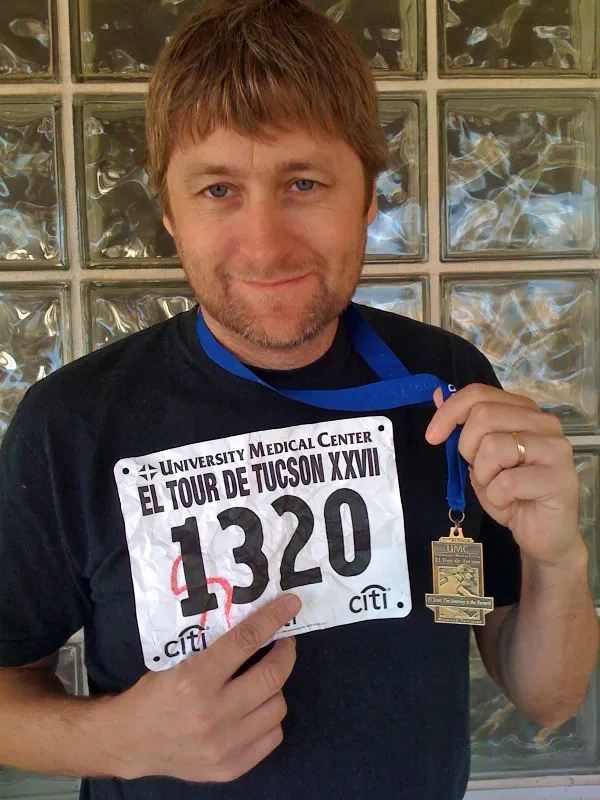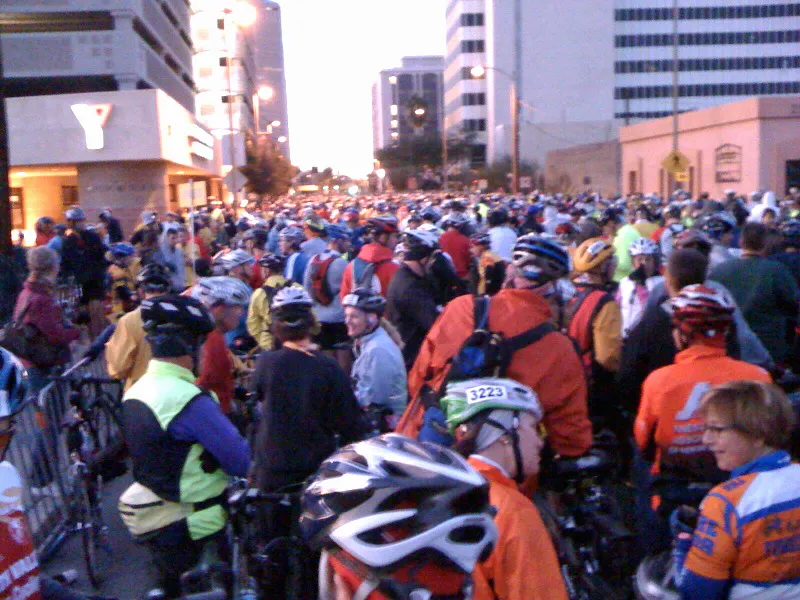I spent seven weeks getting ready for the 109-mile El Tour de Tucson, so when I crossed the finish line last Saturday it was excruciating to learn that I'd have to wait for results to be posted before I'd know if I'd reached my goal of five hours, 30 minutes.
But I don't want to get ahead of myself, so let's go back to the beginning. I felt like I'd managed the final few days before El Tour properly. I'd tapered off my riding and focused on rest, hydration and nutrition.
I drove to Tucson on Friday afternoon and spent some time at the expo, picking up my timing chip, number and packet of final instructions. I grabbed a carbo-loading pasta dinner at a local restaurant and checked into the La Quinta hotel.
Before I went to sleep, I filled water bottles, packed Gu gels, Clif Bars, Clif Bloks and fig Netwon cookies, laid out all my riding clothes, pinned on my number, asked for a wake-up call, then set an alarm on my phone. And set the alarm clock in the room, just in case.
I'd been told multiple times that getting a good place in the starting grid was important for reaching faster time goals. The El Tour start line is laid out in sections across several downtown Tucson city blocks. The Platinum riders line up in the first section. Behind that are the Gold, Silver and Bronze sections. (For more on this see my first blog, El Tour de Tucson: The perfect six-week training plan.) The entire line, once filled, is 500 meters long and, shoulder-to-shoulder, 15 riders across.
I rolled out of the hotel at 5.30am, an hour-and-a-half before the ride was scheduled to kick off. The street was relatively quiet as I unloaded the car a few blocks from the start. I followed a couple of other riders, not really knowing where the start was, and was shocked to find several thousand people already in place in the grid. In the Platinum section, bikes were stacked handlebar to handlebar, balanced on their forks, their front wheels propped sideways under their brake levers – riders holding their space for the official start.
On the start line
Marshalls kept moving me back through the crowd and as I made it to the back of the Gold section, I could see that the Silver group had just been allowed to close the gap between themselves and the back of the Gold group. I threw my bike over the barrier but a marshall jumped towards me. “You have to keep moving back,” he said. “But I'm a Gold rider,” I said. “Gold's closed,” he said, and blocked me from taking a spot.
I worked my way to the end of the Silver section and, luckily, I was able to squeeze in before the Bronze riders closed the gap. I was 3,000 to 3,500 riders behind the leaders, and there was nothing I could do about it.
As you can imagine, I' was stressed and panicking, and figured I had blown any chance of reaching my goal before the ride even started. But I calmed down, accepted my position and reminded myself that I had put in way too much work to give up on my goal so easily.
The countdown commenced. A gun fired. The head of the group started moving. A few short minutes later, the riders in front of me began to roll and before I knew it, I was riding. I relaxed.
I started in the big chainring and picked my way past every person I could safely. Unbelievably, and optimistically, I made huge gains. It felt like I passed 1,000 riders in the first eight miles. Then the course reached a river crossing where all riders had to dismount and we separated into more evenly balanced working pelotons.
From that point until I crossed the finish line, I worked to move up the field. I would fall in with a group of riders then, as soon as I could, try to move off the front, hunting for the next group up the road. I took breaks when I could but every time I felt comfortable, I'd stick my nose back in the wind or pull up a hill, or follow a faster wheel.
I stopped only twice (to urinate and fill water bottles) in the entire ride. I barely noticed the stark high-desert terrain. All I thought about was moving up, eating and drinking (I ate something for every half bottle I drank, alternating between a Gu gel and something more solid). The only moment when I had any idea where I was – I rode with no computer, GPS or watch to distract me – came near the end.
I was on a stretch of road that paralleled the highway. Downtown was within sight, but still several miles away. I had just pulled for what seemed like 20 minutes (but was probably only five). A rider in an orange Alberquerque club jersey took over at the front. Behind me, I heard a woman say to someone else in the group: “It's 12:22 and we have two miles to go.” That left me eight minutes to cover two miles if I was going to reach my 5:30 goal!
Eight minutes and counting
Was I going to make it? My panicked thoughts were filled with the image of writing this blog entry and having to say that I missed my goal by mere seconds. So I shifted down two gears and went back to the front. If I was going to miss, it would be at my own hand.
I pushed the pedals into the wind with all the power I could muster. We blew through another intersection. My legs screamed. My heart hammered. Every breath burned. We turned a corner and I could see a crowd. We rolled across a couple of bumps. I could hear a loudspeaker. I knew we had one turn to go and then we would be at the finish line. And then everyone else in the group sprinted around me to grab one better placement as we rolled through the finish line.
I scanned the scaffolding that crossed the road and marked the finish line but there was no clock. I was wearing no watch. I had no idea whether I had made my goal. At an information desk, I was told where I could pick up my gold medal (for finishing under six hours) and that results would be posted on a wall "over yonder".
The only results thus far were for the Platinum finishers. The winner of the event posted a time of 4:17; blindingly fast for a 109-mile non-race. And finally, after an excruciating 30-minute wait, a new set of pages was taped up. There was a rush to the wall. I had to jostle and nudge my way through the throng, contorting to get a finger on the line with my name on it.
I saw my time: 5:28:21. I'd made it, with less than two minutes to spare! I fist pumped and whooped to myself. Looking over the results online later that night, I saw that I finished 757th out of 3,633 riders. Which meant I passed something like 2,000 people over the 109-mile course. With a better start, I'm convinced I could do it in under five hours next time – if I prepare properly, if I get a little lucky – so I'm hungry to go back to Tucson next year and take a shot at it, and in the meantime, to find other epic challenges to keep my riding focused and keep chasing growth as a cyclist.
Thanks to everyone who has read this blog over the past seven or eight weeks. I appreciate the emails I received encouraging me to keep at the training and to have fun on the ride. And thanks to the organisers of the University Medical Center El Tour de Tucson presented by Diamond Ventures. The 2009 edition was the 27th El Tour, and the professionalism of the event organisers, the co-operation of the city, and the management and support along the course all let the maturity of those 27 years of experience shine. Until next year...

